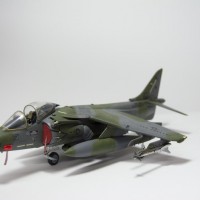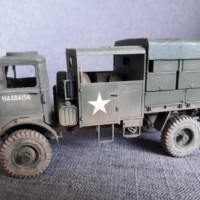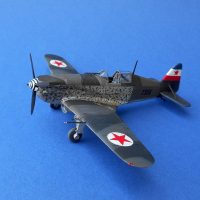Grumman G-22 Gulfhawk II
Here's my build of the Grumman G-22 Gulfhawk II from Accurate Miniatures in 1:48. A really nice kit OOB, like their F3F-1 and F3F-2 kits.
One of the most exciting aircraft of the interwar period was the Grumman G-22, a one of a kind aircraft built for the Gulf Oil Company in 1936. Powered by a 940hp Wright GR-1820-GI, the G-22 was a hybrid using the wings of the F2F, the fuselage and powerplant installation of the XF3F-2, and the enlarged vertical tail surfaces of the F3F-2s but without the increase in fin area below the tailplane. Modifications were made during construction to withstand the high-load factors encountered during aerobatics and the aircraft was equipped with an inverted fuel and oil system to permit inverted flight for periods up to a half hour. It was given the registration NR 1050 and named the Gulfhawk II and painted in the scheme of it's predecessor, a Curtiss 1A Hawk also owned by Gulf Oil. It first flew on December 6, 1936.
As head of the Gulf Oil Company's aviation department, retired naval aviator Al Williams flew the Gulfhawk II in civilian and military airshows around the country, performing precision aerobatics.
In 1938, Williams flew the Gulfhawk II in Europe where aviation enthusiasts in England, France, Holland, and Germany were treated to his daring maneuvers in the colorful little biplane. During this overseas visit the only other person ever to fly the Gulfhawk II was the famous German World War I ace Ernst Udet. In exchange, Al Williams became the first American to fly the vaunted Messerschmitt 109.
The Gulfhawk II also became a flying laboratory. A new pilot's throat microphone was tried out in it in 1937 and during Word War II it was used to test oils, fuels, and lubricants under extreme operating conditions. In 1942, at the request of General H.H. Arnold, Williams made a three-month tour of fighter schools and training bases to demonstrate airmanship and precision aerobatic flying to pilot trainees.
On October 11, 1948, the Gulfhawk II, NR1050, made its last flight before its donation by the Gulf Oil Corporation to the National Air and Space Museum. At Washington National Airport, Major Williams took his airplane through a demonstration of aerobatics, and then taxied to a strip adjacent to the airport administration building where he shut off the engine and removed the control stick, thus formally decommissioning the historic airplane. The aircraft is now on display at the Air & Space Museum.
















You were lucky to get a kit from the second run, where the resin wings weren't botched.
Nice result on this.
I saw the original when I visited the Air and Space Museum. It's an excellent replica of a very nice little aircraft.
Excellent Gulfhawk, Chas!
A very nice build, Chas @chasbunch
Nicely done! I remember seeing the Gulfhawk at the Smithsonian when I was a kid I was a kid in the mid 50s. My Dad worked for Gulf Oil his whole professional career and he told me stories about Al Smith and the airshows.
Very cool, thanks for sharing.
Rod
Beautifully done! That scheme is a standout, and an excellent model all the way around.
Nice build again Chas, love it.
Excellent build and an interesting story on the plane, Chas. Beautiful pictures too! BTW how did make the prop spin? Thanks for sharing.
Thanks, Alfred. I use telescoping brass tubing for prop shafts and crankcase bushings. A hair dryer spins the prop.
Great!
Great job, Chas
Beautiful work, I like it very much.